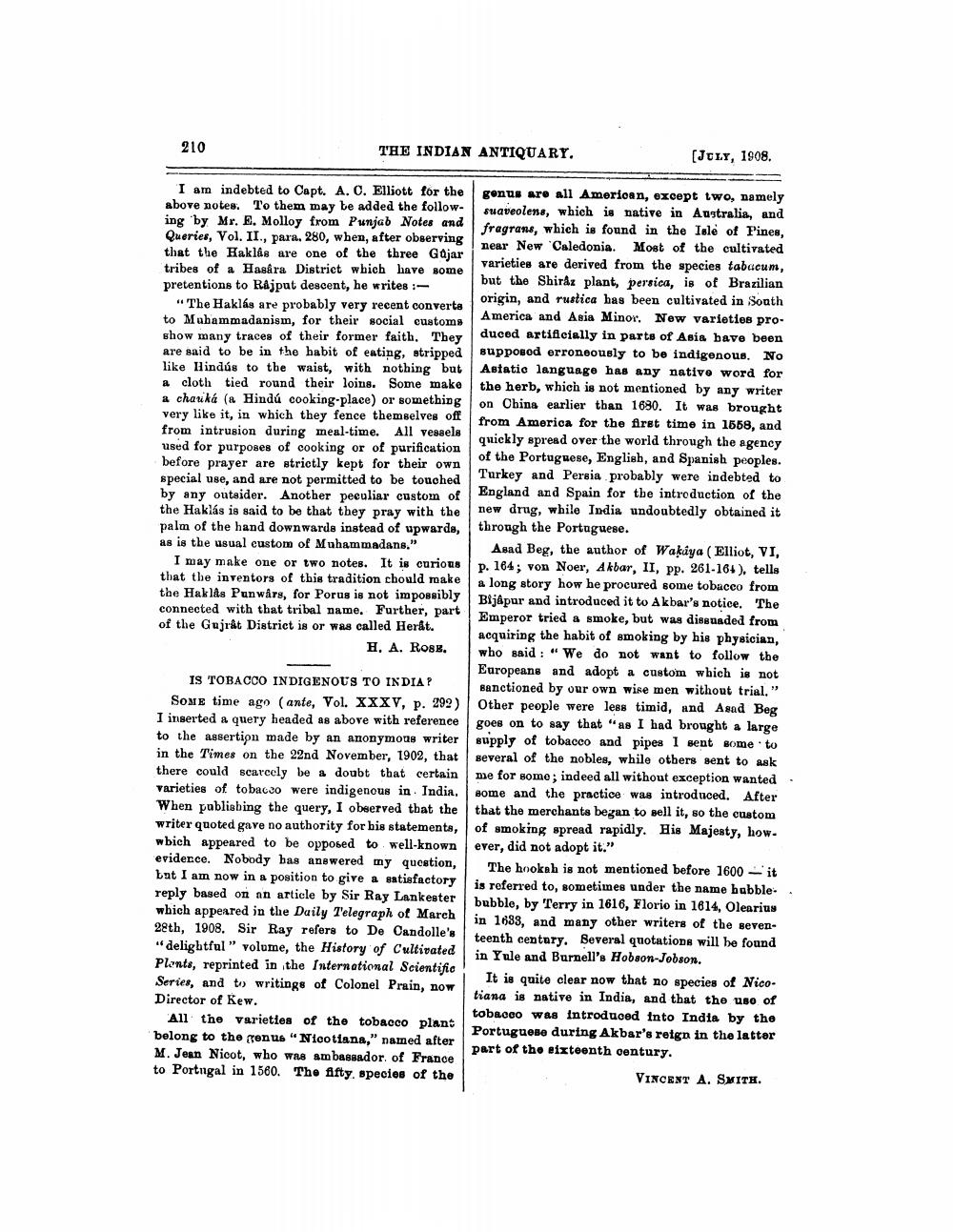________________
210
THE INDIAN ANTIQUARY.
[JULY, 1908.
I am indebted to Capt. A. C. Elliott for the
gonus are all American, except two, namely above notes. To them may be added the follow
suaveolens, which is native in Australia, and ing 'by Mr. E. Molloy from Punjab Notes and
fragrans, which is found in the Isle of Fines, Queries, Vol. II, para, 280, when, after observing
near New Caledonia. Most of the cultivated that the Haklas are one of the three Gajar
varieties are derived from the species tabacum, tribes of a Hasara District which have some
but the Shiraz plant, persica, is of Brazilian pretentions to Rajput descent, he writes :"The Haklás are probably very recent converta
origin, and rustica has been cultivated in South
America and Asia Minor. Now varieties proto Muhammadanism, for their social customs show many traces of their former faith. They ducod artificially in parts of Asia bave been are said to be in the habit of eating, stripped
supposed erroneously to be indigenous. No like Hindús to the waist, with nothing but Astatic language has any native word for a cloth tied round their loins. Some make the herb, which is not mentioned by any writer & chauká (a Hindú cooking place) or something on Obins earlier than 1680. It was brought very like it, in which they fence themselves off
from America for the first time in 1558, and from intrusion during meal-time. All vessels
quickly spread over the world through the agency used for purposes of cooking or of purification
of the Portuguese, English, and Spanish peoples. before prayer are strictly kept for their own
Turkey and Persia probably were indebted to special use, and are not permitted to be touched by any outsider. Another peculiar custom of
England and Spain for the introduction of the the Haklás is said to be that they pray with the
new drug, while India undoubtedly obtained it palm of the hand downwards instead of upwards, through the Portuguese. as is the usual custom of Muhammadans."
Asad Beg, the author of Wakuya (Elliot, VI, I may make one or two notes. It is curious p. 164; von Noer, Akbar, II, pp. 261-164), tells that the inventors of this tradition chould make a long story how he procured some tobacco from tbe Haklas Pun warg, for Porus is not impossibly Bijapur and introduced it to Akbar's notice. The connected with that tribal name. Further, part
Emperor tried a smoke, but was dissuaded from of the Gujrat District is or was called Heråt.
acquiring the habit of smoking by his physician, H. A. Rose,
who said: "We do not want to follow the
Europeans and adopt a custom which is not IS TOBACCO INDIGENOUS TO INDIA?
Banctioned by our own wise men without trial." Some time ago (ante, Vol. XXXV, p. 292) Other people were less timid, and Asad Beg I inserted a query headed as above with reference goes on to say that was I had brought a large to the assertion made by an anonymous writer supply of tobacco and pipes 1 sent some to in the Times on the 22nd November, 1902, that several of the nobles, while others sent to ask there could scarcely be a doubt that certain me for some; indeed all without exception wanted. varieties of tobacco were indigenous in India, come and the practice was introduced. After When publishing the query, I observed that the that the merchants began to sell it, so the custom writer quoted gave no authority for his statements, of smoking spread rapidly. His Majesty, how. wbich appeared to be opposed to well-known ever, did not adopt it." evidence. Nobody bas answered my question,
The hookah is not mentioned before 1600 -it hat I am now in a position to give a satisfactory is referred to, sometimes under the name babble. reply based on an article by Sir Ray Lankester bubble, by Terry in 1616, Florio in 1614, Olearius which appeared in the Daily Telegraph of March
in 1883, and many other writers of the seven28th, 1908. Sir Ray refers to De Candolle's
teenth century. Beveral quotations will be found "delightful" volume, the History of Cultivated
in Yule and Burnell's Hobson-Jobson. Plonts, reprinted in the International Scientific Series, and to writings of Colonel Prain, now
| It is quite clear now that no species of Nico
tiana is native in India, and that the uso of Director of Kew.
tobacco Was Introduced into India by the All the varieties of the tobacco plant belong to the genus "Nicotiana," named after
Portuguese during Akbar's reign in the latter M. Jean Nicot, who was ambassador of France
part of the eixteenth century. to Portugal in 1560. The fifty species of the
VINCENT A. SMITH.




